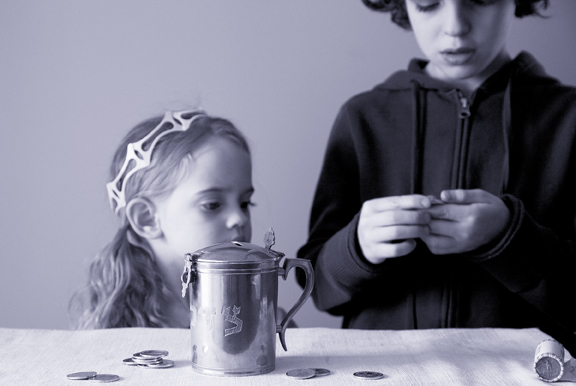Making an impression

Back to basics: a new series
Jewish Family Education with Candace R. Kwiatek, The Dayton Jewish Observer
Research over the past two decades has led to fascinating conclusions about environmental influences on thinking and behavior.
We’re all familiar with the effects of music on buying habits. But did you know that a subtle scent of cleaning liquids prompts people to be cleaner and tidier?
A nearby briefcase or just its picture encourages competitive behavior, while reading words like “dependable” and “support” stimulate cooperative behavior. People smile more after seeing a “smiley” sticker.
Author Mark Tyrrell notes in the essay How your environment influences you that this ever-present phenomenon of “environmental suggestion” can have a profound impact on character.
In a similar vein, renowned 20th-century educators Jean Piaget and Maria Montessori emphasized the importance of a child’s surroundings for learning and identity formation.
Montessori’s “prepared environment” and Piaget’s “rich environment” are still considered best practices in early childhood education.
In fact, a recent U.S. Department of Education study of more than 20,000 kindergartners through fifth graders (Early Childhood Longitudinal Study) suggests that the mere presence of such environments positively influences children.
It reported that a child who has 50 books at home scores five percent higher than a child with none, and a child with 100 books scores an additional five points higher, regardless of the time spent reading.

What does all this have to do with fostering Jewish identity and menschlichkeit in our children and grandchildren?
It means that positive Jewish role modeling is only one factor in the nurturing process. The environment just as powerfully impacts youngsters’ thinking, behavior, and character in both overt and subtle ways.
Creating a Jewish environment begins in the home. “We visit the synagogue. We live in our homes…Judaism believes that the most central house of God is not the synagogue but the home,” writes Rabbi Benjamin Blech in The Complete Idiot’s Guide to Understanding Judaism.
In Raising Kids to Love Being Jewish, author Doron Kornbluth elaborates, “Home is where (children) spend most of their time and where they learn about life. By displaying outward signs of your Jewish identity, you are also showing that being Jewish is one of the main parts of your life,” — and a beautiful part of life in general.
While a “prepared and rich” Jewish environment will look different from family to family, every version needs to reflect two things: Jewish identity and Jewish values.
Here are my top seven universally applicable and easily implemented environmental elements that make a Jewish impression.
1. The biblical Creation story teaches that the universe has structure and order. Creating a home environment that embodies these principles — clean-up rituals, daily pet care, regular “Jewish moments” such as bedtime rituals or Shabbat celebrations — encourages the child to discover patterns and thereby make sense of the world.
2. Medieval scholar Ibn Tibbon wrote, “It is your books that are your true treasure.” In Bringing Up Baby: A Jewish Education Primer, Rabbi David Orlofsky elaborates, “The things we use to decorate… impress our children with what we value…Let your children see that (Jewish books) are more important to you than valuable antiques or china.”
Echoing the conclusions of modern research, the last Chabad-Lubavitch Rebbe, the late Menachem Mendel Schneerson, said, “Even if the books lie dormant on their shelves, their mere presence will permeate the entire home, positively influencing its residents both while at home and into the outside world.”
Collect books, display them, read them — because we are the People of the Book.
3. A mezuzah reminds us to aspire to moral and ethical character both in the home and in the world. Similarly, a tzedakah box represents Jewish foundational obligations to justice and to those in need. Both also illustrate the notion of hiddur mitzvah, making a mitzvah aesthetically beautiful.
4. The rhythm of Jewish time becomes visible on a Jewish calendar, and its celebrations and observances become more familiar and inviting when seen in context, year after year.
5. Jewish art is “anything that emphasizes our connection to the Jewish people, the Jewish land, Jewish history, or Judaism itself,” Kornbluth writes. Family heirlooms, Israeli art, ancient coins, ritual items, and other collectibles create an environment that visually celebrates Jewish identity.
6. The familiar expression “Ess a bissel – Eat a little!” says it all about Judaism’s relationship to food. From familiar recipes to exotic ethnic cookbooks, there is no end to the possibilities for exploring, experimenting, and eating.
7. Through play, children engage and interact with the world around them, learning about their environment and about themselves. Jewish toys alongside the traditional toy store stash offer the subliminal message that Judaism is fun, engaging, and part of everyday life.
If we’re serious about raising Jewish children and strengthening Jewish identity, we should consider how to “seed” our home environments so they reflect the elements of Judaism that bring joy and meaning to our lives.
And maybe we should consider adding just one thing that challenges us to learn and grow as well.
Literature to share
Lola Levine is Not Mean! by Monica Brown. Entering the multicultural genre is the new Lola Levine series featuring the feisty, competitive, and big-hearted second-grader Lola. Raised by an American Jewish father and a Peruvian Catholic mother, Lola is an independent problem-solver and a caring person. Considered among the best Jewish children’s books of 2015, the new Lola Levine series promises to be an excellent addition to chapter books for the early elementary set.
Nine Essential Things I’ve Learned About Life by Harold Kushner. Part memoir and part philosophy, Nine Essential Things explores the intersection between Judaism and modern-day challenges about mercy, conscience, God, and more. Kushner’s conversational tone and use of anecdotes from multiple sources including his own rabbinic experience create a highly accessible and thought-provoking work.
To read the complete July 2016 Dayton Jewish Observer, click here.


